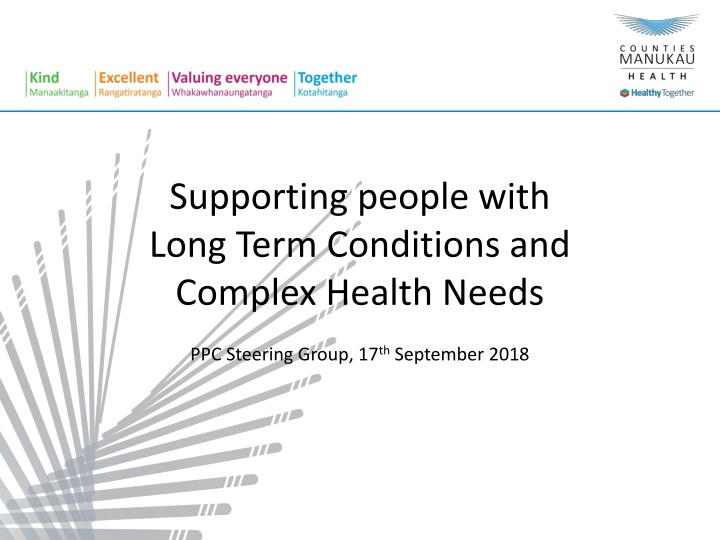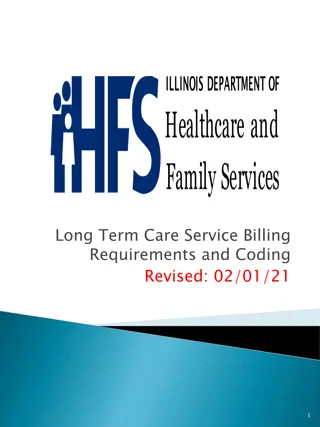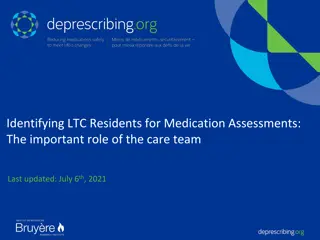
Enhancing Health Care Delivery: Co-Design Principles and Opportunities for Change
Explore how the principles of co-design in health care aim to involve all stakeholders for better outcomes. Discover what has been effective, challenges faced, and opportunities for improvement in health care processes. Embrace a patient-centered approach and align funding with patient needs for impactful change.
Download Presentation

Please find below an Image/Link to download the presentation.
The content on the website is provided AS IS for your information and personal use only. It may not be sold, licensed, or shared on other websites without obtaining consent from the author. If you encounter any issues during the download, it is possible that the publisher has removed the file from their server.
You are allowed to download the files provided on this website for personal or commercial use, subject to the condition that they are used lawfully. All files are the property of their respective owners.
The content on the website is provided AS IS for your information and personal use only. It may not be sold, licensed, or shared on other websites without obtaining consent from the author.
E N D
Presentation Transcript
Supporting people with Long Term Conditions and Complex Health Needs PPC Steering Group, 17th September 2018
Principles of the co-design process True Partnership enable the active involvement and participation of people who are impacted by the design of health and care processes and systems. This includes consumers, carers, health workers, families and whaanau Respect the expertise of all involved, ensure that all have an equal voice and practice shared ownership Teamwork work together on a shared goal, trust the process and learn together Safety is paramount for all involved. Maintain an environment which feels safe and brings confidence for everyone Value the lived experience of delivering and receiving care Be True to the process, the means is as important as the end.
What has been working well?: Team based care Holistic and patient-centred Shared cared and team based care including health coaches Supports continuity Care planning Collaborative process driving self-management support Patient-centeredness and an opportunity to problem solve with patient Care Co-ordination Clinical and health coach partnership Warm handovers Whaanau ora principles (e.g.: coordination and family centred where possible) Flexibility Use funding for a variety of purposes, e.g.: transport and medication; home visits by health care assistant to provide outreach service for those not engaging or hard to reach Allows for innovative model development Supports addressing social determinants of health
What has not been working so well?: Administrative burden takes away from time to care for patients Too many contracts, too many KPIs, too many unhelpful assessments, not enough alignment Lack of clear goals and programme logic Problems not clearly identified what are we trying to solve? Large target population, limited funding Goal posts changing Outcomes difficult to quantify and accurately measure Lack of practice level data to direct and support quality improvement Variation in models of care Shared Care platform not fit for purpose
What are the opportunities for change?: Greater focus on patients and whaanau Funding better aligned to patient need and better targeted Work with a smaller number of patients/whaanau but more meaningfully Reduce fee for service, fund for teams and outcome Providing more services outside of clinical settings and support the social determinants Increase culturally safe services Take a wellness and psychosocial approach Reduce administration Support innovative models of care Capture gold nuggets of practices who improved their model of care Build on Enhanced Primary Care model of care changes Equity-based primary care funding Engaging with consumers so that they can be confident and able to achieve best health and wellbeing Build change capability and leadership Implement health coach/navigator role Intersectoral assessment, planning and delivery involvement (i.e.: social, justice, education, etc.) Greater Consumer input Co-design with population at risk Measure a range of outcomes
Insights from deep-dive practices about the key components of an effective model of care include: Flexibility and addressing wellness and the social determinants Engagement and relationship building Patient and whaanau based assessment and planning Team based care Culturally safe models of care Coordination and continuity Accountability






















